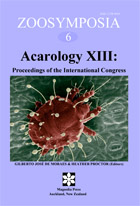Abstract
The key subject of this investigation was to study distribution patterns of oribatid mites in the main habitats and ecosystems of Kolkheti National Park. Oribatida were studied in 1) sand dunes, 2) Juncus bogs, 3) flooded alder (Alnus barbata C. A. Mey) forests, and 4) humid alder forests. Sampling was conducted in November 2009 at 18 sites along three transects. For exploratory analysis, we applied clustering techniques. Correlation between species number, density and humus was calculated. Chao1 statistics were used to estimate the completeness of sampling. Forty six oribatid species were recorded. The highest Shannon diversity index was registered for alder forests, whereas the lowest index was observed for dunes. In sand dunes 16 species were found, three of which occurred only in this landscape. In Juncus bogs, 32 species were recorded, and 16 were unique to this landscape, including bog specific Zetomimus furcatus (Warburton & Pearce, 1905), Euzetes globulus (Nicolet, 1855) and Punctoribates manzanoensis Hammer, 1958. Twenty two species were found in flooded forests, seven being exclusive. Ten species were recorded in humid forests, and Metabelbella macerochaeta Bulanova-Zachvatkina, 1965 and Eremobelba geographica Berlese, 1908, typical inhabitants of humid forest soils, appeared as exclusive species. Faunal comparisons among landscapes show high similarity between dune and bog oribatid mite communities, followed by flooded and humid alder forests. In dunes and bogs, total faunal density is determined by euryecological species, whereas in alder forests density was determined by high abundance of humid and extremely humid specific species.

